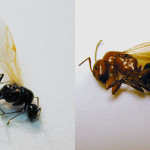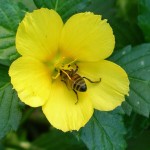All Bugs Good & Bad Webinar Series- begins February 7, 2014!
The eXtension All Bugs Good and Bad Webinar series is set to begin February 7, 2014. Dr. Kathy Flanders, an entomologist with the Alabama Cooperative Extension System, says the series is a continuation of the Don’t Bug Me Webinar series with an emphasis on good and bad insects that affect people every day.
“This webinar series will feature insects that affect homeowners and gardeners,” says Flanders. “These insects fall into two categories and we hope to provide information that is beneficial when treating your gardens or crops and pest-proofing your home, yard, family and pets.”
Webinars will be held the first Friday of each month at 2 p.m. Eastern Daylight Time. The first webinar in the 2014 series will highlight pollinators, which are good bugs. “If flowers are restaurants to bees, then what are bees to flowers?” will be Friday, February 7th at 2 p.m.
Dani Carroll, a region Extension home grounds agent, will be moderating the February 7th webinar. She says it is imperative to know the importance of the role pollinators play in the world around us.
“Bees and other pollinators are essential in production of more than two-thirds of the world’s food crop species,” Carroll says. “The necessity extends beyond things we grow in our back yard, like squash and apples. Alfalfa is instrumental in the meat and dairy industries and its growth depends on pollination.”
Upcoming webinar topics include pollinators, termites, ticks, spiders and fire ants.
Flanders says The All Bugs Good and Bad Webinar series is designed to provide useful tips for those interested in solid, research-based information.
More information can be found at All Bugs Good and Bad 2014 Webinar Series including how to connect to the webinars. On Feb. 7, participants can use this link to connect to the webinar. Webinars will be archived and can be found on the All Bugs Good and Bad 2014 Webinar Series page.
All Bugs Good and Bad webinars are an extension of the seven webinars in The Don’t Bug Me Webinar Series, which spanned most of 2013, and included five webinars discussing fire ants, tramp ants, bed bugs and insects that invade homes. Links to view these archived webinars can be found here.
The webinars are sponsored by eXtension, and the Alabama Cooperative Extension System. They are coordinated by the Imported Fire Ant eXtension Community of Practice, Urban IPM, Bee Health, Invasive Species, Gardens, Lawns and Landscapes, and Disasters.
Carpenter ant season is now, By Mike Merchant
Many social insects periodically do something called “swarming.” Swarming occurs when reproductively mature, but unmated, kings and queens leave the nest to mate. These mating couples are winged and are referred to as alates, or swarmers. The earliest swarmers to emerge in the winter are carpenter ants.

Male (left) and female carpenter ant swarmers. Note the pinched waist that distinguishes these insects from termites.
This week my youngest daughter, home for the weekend for a visit, informed her entomologist dad that the upstairs shower was covered with large ants. A quick inspection confirmed that we were being invaded by carpenter ants. A few years ago we remodeled this particular shower, tearing out sheet rock and insulation and encountered carpenter ants living in the surrounding walls. We throughly cleaned out what we could and sprayed the walls down with a residual insecticide before reinstalling insulation and more water-resistant Hardyboard® in the new shower stall. Apparently, they are back.
Carpenter ants are relatively large for ants, 1/4 to 1/2 inch-long. They may come in different colors, but are usually red or black, or a mixture of the two colors (see pictures). They may or may not have wings. In my home I only spotted the wingless worker ants, but I suspect the swarmers will show up soon. Dozens, even hundreds of swarmers may emerge from an indoor carpenter ant nest.
In some parts of the U.S. carpenter ants are important wood-destroying pests–not something that any homeowner wants to see in their house. But here in Texas our carpenter ants are a little less threatening. They certainly can be a nuisance through their presence, and for the little piles of debris they often deposit on windowsills and floor near their nests. However, they do not do significant damage to 2×4 studs or other structural wood.
Unfortunately, carpenter ants are always difficult to treat and eliminate completely from the home. For my part I plan to inject an insecticide into the gap in the shower grouting from which they obviously emerged, reseal the grout and not lose much sleep over the incident.
If you discover carpenter ants in your home, business, or school, look for the hole where they are emerging. This may or may not mark the exact location of the nest, but it will be close. For most people, calling a professional is the best option for control. If you choose to try the DIY route, you can either seal up the hole and do nothing, or attempt to treat the hole with an aerosol insecticide labeled for use indoors against ants and then seal the hole. You may be fortunate, and eliminate the colony in this way, or you may eventually have to resort to professional assistance. In any case, doing nothing to the ants will not likely result in any serious damage to the home…just some nuisance ants emerging from time to time.
For more information about these ants, see publication E-2001 on carpenter ants, or the publication on swarming insects indoors, Ent-2012.
Report on the Winter Structural Pest Control Advisory Committee Meeting By Mike Merchant
Texas Department of Agriculture’s quarterly Structural Pest Control Advisory Committee meeting was held on January 23, 2014. The purpose of the committee is to advise the TDA and its commissioner on education and curricula for PMPs, examinations, proposed rules and standards on technical issues related to pest control, fees and other issues affecting the practice of pest control in Texas.
Today’s meeting was relatively brief, but informative. We met two TDA staffers that work actively behind the scenes on pesticide-related issues. Rafael Paonessa is in charge of reviewing and approving the structural pest control CEU courses that all license holders must attend each year. Rafael is the person I deal with to get approval for CEU classes that we offer. He is always efficient and easy to work with. He reported on recent overhauls of forms and procedures used in the re-certification program.
The biggest changes in the recertification process are in how course providers handle class attendance records, a subject I wrote about in detail last November. The most common issue in getting courses approved, he said, is when providers do not provide enough detail about the planned course(s). It’s important to provide enough information for his office to determine whether the course meets department guidelines. It’s also important that class content relates directly to pesticide use or pest management. General horticultural topics, or workplace safety topics (unrelated to pesticide safety), for example, will not be approved. The department does conduct spot checks of CEU classes to make sure the content is being covered and does not consist of advertising for a particular product or company. Detailed information on putting together a course for CEUs is available in the just revised Pesticide Recertification Course Accreditation Guide, which is available online.
The other employee we met today was Dale Scott. Dale handles the pesticide product evaluation and registration system at TDA. Many people believe that EPA is THE agency that approves pesticide labels, but in fact all pesticides must also be registered by each state in which they will be sold. This is why not all pesticides are registered, or legal for use, in all states. Approximately 16,000 pesticide labels are registered in the state at any time, and his office processes about 3,500 new pesticide registration requests every year.
A new EPA-mandated Pollinator Protection Icon will appear on many new pesticide labels starting in 2015.
Dale reviewed information about new pollinator protection guidelines that are beginning to appear on pesticide labels. Four neonicotinoid insecticides will be the first insecticides to come under the new pollinator protection label guidelines. Changes to look for include pollinator protection information under all Directions for Use statements, a new bee icon to draw attention to pollinator protection information, and consistent warning label language about applying insecticides when bees are actively foraging. This is a topic that all pest management companies and technicians should be aware of. Dale promised to make his PowerPoint on the topic available to the committee.
Also, Maron Finley, IPM in Schools specialist in the department reported on the top ten violations found in school IPM program inspections this past year. Most, he noted, related to inadequate record keeping. In order, they included:
- No written guidelines that identify pest thresholds. (155 violations, 39% of schools)
- Not maintaining records showing approvals of Yellow Category pesticides (93 violations, 23% of schools)
- IPM program records not maintained for the required time period (64 violations, 16% of schools)
- IPM Coordinator not conducting periodic facility inspections (63 violations, 16% of schools)
- No system for keeping records of facility inspection reports, pest control service reports, or pesticide applications (57 violations, 14% of schools)
- No plan for educating and informing school district employees about their roles in the IPM program (54 violations, 13% of schools)
- No monitoring program to determine when pests are present (48 violations, 12% of schools)
- No reference [in the IPM policy] to Texas laws and rules governing pesticide use and IPM in schools (40 violations, 10% of schools)
- IPM Coordinator training not completed within six months of appointment (32 violations, 8% of schools)
- Name and license numbers of persons applying pesticides not on file (31 schools, 8% of schools)
A more serious violation, which occurred only 10 times, and did not make the Top Ten list, was applications made by non-licensed applicators. Maron noted that 9 of these violators were small, class 1A to 3A, schools, and that all were in rural communities.
Several on the committee commented that the overall violation rates seem low, and that compared to when the school IPM program first started, the state has made very good progress. Nevertheless, everyone agrees that there is more work to be done to increase compliance. Stephen Pahl expressed the desire for TDA to do more outreach to school administrators. TASB, TASBO, and TASA are three school-oriented organizations that have ongoing meetings where school IPM talks can be presented. George Scherer, of Texas Association of School Boards, was present and commented during public testimony that it is possible to get the names and contact information for school board members if needed during the compliance assistance phase of helping a school district.
Arnold Anderson, from Katy ISD, provided testimony on the subject of violations during the public comment portion of the meeting. He suggested that schools with little experience in IPM should be encouraged to seek out a mentor school district rather than being fined. A suggestion was made that perhaps the TDA could facilitate mentoring by maintaining a current list of districts willing to mentor other districts in their IPM program development. This might be another way TDA could reduce the number of school IPM violations without having to resort to administrative fines or penalties.
Finally, we were advised today that there is still an opening on the Advisory Committee. If you know of someone who is not connected directly or indirectly with the pest control industry, and is interested in serving as a public member of the committee (with no pay or travel reimbursement), Leslie Smith is accepting applicants.


 .
.